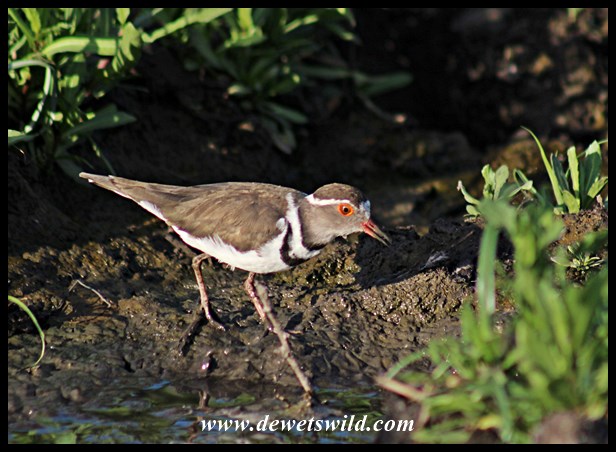Charadrius tricollaris
Three-banded Plovers inhabit the open, often muddy, shores of freshwater and brackish habitats, natural or man-made, and feed on a wide variety of worms, insects, molluscs, crustaceans and other invertebrates foraged from the water’s edge. They are usually seen singly or in pairs, with small flocks of up to 20 a rare occurrence. Adult Three-banded Plovers weigh between 28 and 45g, with a wingspan of around 46cm.
Nests are little more than well camouflaged scrapes in the ground, placed near the water among gravel, pebbles, rocks or other debris, in which one or two eggs are incubated by both parents for around four weeks. Pairs vigorously defend their territories from other Three-banded Plovers and even other kinds of birds. The chicks fledge about three weeks after hatching, but remain with their parents until they’re about 6 weeks old. This species breeds throughout the year.
The Three-banded Plover occurs all over South Africa, and has expanded its range in recent times thanks to the construction of artificial water bodies in otherwise arid areas. In the rest of Africa it occurs widely over the eastern and central parts of the continent and is considered of least concern by the IUCN, who sites a total population of between 70,000 and 140,000 (of which between 25,000 and 50,000 is estimated to occur south of the Zambezi River).































Hoe lyk dit Dries, smokkel vir ons die Afrikaans en Zulu name ook in? Ek wonder elke keer as jy my herhinder aan ‘n voël sien wat ek vergeet het! 🤔🤨😃
LikeLiked by 1 person
Hi AJ – Jy sal reeds die Afrikaanse name in die “tags” van elke post vind! 😉
LikeLike
It is always special to come across a Three-banded Plover. An interesting post.
LikeLiked by 1 person
Thanks Anne! We agree that Three-banded Plovers are very special little birds.
LikeLike
Hier is darem n paar verskillende kiewiete! Hul geluid klink oog eg kiewiet!
LikeLiked by 1 person
So die see was nie wyd genoeg om die kiewietjies te keer nie!
LikeLike
Ja wat hul is ook maar permanente inwoners nou. Juis vanoggend weer twee al skreeuende hier rondgevlieg.
LikeLiked by 1 person
Such pretty birds, Dries. Great shots too. 😃
LikeLiked by 1 person
Thank you very much, Sylvia!
LikeLiked by 1 person
Another cool bird.
LikeLiked by 1 person
Such a joy to watch as they go about their business on the water’s edge.
LikeLiked by 1 person
So stress relieving.
LikeLiked by 1 person
Absolutely!
LikeLiked by 1 person
Very beautiful waders. Reminds little about ringed plover, who is on the way to South Africa now. 🙂
LikeLiked by 1 person
Actually a Little Ringed Plover is causing great excitement among bird watchers here in South Africa now, John, as they normally don’t migrate all the way down to us (they usually only venture as far as the equator).
LikeLiked by 1 person
I meant the common ringed plover. According to Wikipedia, it is also in South Africa, when it is winter here in Sweden.
LikeLiked by 1 person
You are quite right, John. Another close relative!
LikeLiked by 1 person
The color really emphasizes the eyes.
janet
LikeLiked by 1 person
And from the right angle those eyes can look pretty irate!
LikeLiked by 1 person
We have snowy plovers here in Florida. They are probably somehow related…you think? We could be cousins! 😀
LikeLiked by 1 person
If Wikipedia is to believed then yes, close cousins!
LikeLiked by 1 person